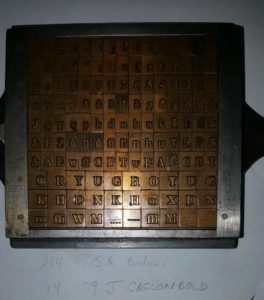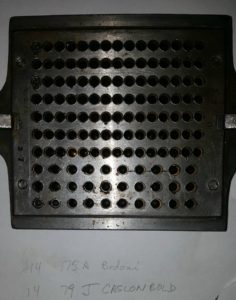I have a matcase for Monotype composition casting that is a bit of a mystery to me.
 Some of it is easy to figure out: This case contains 14-point 175A Bodoni and 14-point 79J Caslon Bold (with french accents). I found this by disassembling the case and inspecting the markings on the individual matrices. This is a Lanston-style case with the “combs” to separate the matrices rather than the English style case with the rods and perforated plates.
Some of it is easy to figure out: This case contains 14-point 175A Bodoni and 14-point 79J Caslon Bold (with french accents). I found this by disassembling the case and inspecting the markings on the individual matrices. This is a Lanston-style case with the “combs” to separate the matrices rather than the English style case with the rods and perforated plates. The unusual feature is the size and spacing of the individual matrices: The mats are 0.2×0.3″ and 0.3×0.3″ and anyone at all familiar with Monotype composition casters will know that the matrices should be all positioned on a 0.2″ grid. The caster can only position the matcase at multiples of 0.2″ and so would not be able to position to every second row in this matcase, nor to any second column in the bottom three rows.
The unusual feature is the size and spacing of the individual matrices: The mats are 0.2×0.3″ and 0.3×0.3″ and anyone at all familiar with Monotype composition casters will know that the matrices should be all positioned on a 0.2″ grid. The caster can only position the matcase at multiples of 0.2″ and so would not be able to position to every second row in this matcase, nor to any second column in the bottom three rows.
The benefit is the ability to have two full upper/lowercase alphabets, which is not possible using the standard Large Composition matcase layouts (used for sizes over 13 point). Large Comp uses mats that are double-width and/or double-height and so fitting even a single alphabet, figures, and points, is tight.
I had thought that one would need a caster fitted with custom airpin blocks, with the airpins spaced 0.3″ apart, and locking racks to match. You could kludge the Unit Shift mechanism (making it shift 0.1″ instead of the usual 0.2″ with customized matrix jaws) to avoid needing a custom front pin block. But then further thought reveals that the rear pin block needs not only the standard 0.2″-spaced positions (for the top 7 rows in the case) but also the 0.3″-spaced positions (for the bottom 3 rows). So the rear pin block would need 20 addressable positions with somewhat staccato spacing. Getting that many airpins in there may be possible, but then what ribbon punch combinations would address these (the normal punch combinations can address 17 positions)?
And of course, the easy bit, the normal wedge would need to be made with only ten positions corresponding to the ten rows in the matcase.
The wear on the rear cover of this case indicates that it has been used. So does anyone have any useful observations on this? Is this some experiment that escaped the development lab? Or was some Monotype client big enough to afford all the caster customizations required to make this work?
Some answers can be found in my follow-up post.

I think this is a “quadrant” mat case for use on the last-gasp development by Lanston Monotype of their Monomatic. It had 4 separate mat cases and somehow positioned them over the mold in what was an attempt to make the caster more versatile and productive. Rich Hopkins had one, and I think M&H had (or still have) one.
Anyone out there familiar with this machine? My memories a little fuzzy about the details.
Pat Reagh
Thanks for the idea, Pat, but I don’t think that is it.
As I recall, the Monomatic matcase held four quadrants of matrices (though I don’t recall the quadrant size, for some reason 10×10 rings a bell). However the machine still operated on the 0.2″ grid concept; the larger matcase just made for more room for the 0.4″ mats used by large comp.
Also, though not shown in the photos, this really is on the outside a standard Monotype comp matcase that I could fit in my caster today and cast perhaps 1/3 of the mats that happen to be on the 0.2″ grid. I do have an empty Monomatic mat case kicking around somewhere and this isn’t one.
This is not a Monomatic diecase. The Monomatic used an 18×18 diecase. Each quadrant was 9×9 and could hold an entire font. The width was punched into the ribbon so a matrix of any width could be anywhere in the diecase.
Bill Welliver has stated on the Letterpress mailing list that these were part of a very early Lanston large comp system that became a development dead end.
That was one of my suspicions.
Now, is there any way of reusing these mats? A special mat holder for a Thompson would do the trick, but I doubt that it is worth the trouble for common faces like Bodoni and Caslon.
I found the definitive description of this in my copy of The Monotype System (second edition, 1916, by Lanston Monotype Machine Co.), sections 526-535 (pages 227-231).